Serviços Personalizados
Journal
Artigo
Indicadores
-
 Citado por SciELO
Citado por SciELO -
 Acessos
Acessos
Links relacionados
-
 Similares em
SciELO
Similares em
SciELO
Compartilhar
Finisterra - Revista Portuguesa de Geografia
versão impressa ISSN 0430-5027
Finisterra no.96 Lisboa jun. 2013
ARTIGO ORIGINAL
Modes of neighbourhood embeddedness in three multi-ethnic neighbourhoods in Lisbon. An exploratory analysis
Modos de integração em três bairros multi-étnicos de Lisboa. Uma análise exploratória
Maria Lucinda Fonseca1; Jennifer McGarrigle2
1Professor in the Institute of Geography and Spatial Planning and researcher at the Centre for Geographical Studies, University of Lisbon. E-mail: fonseca-maria@campus.ul.pt
2Researcher at the Centre for Geographical Studies, University of Lisbon. E-mail: jcarvalho@campus.ul.pt
ABSTRACT
The role of urban neighbourhoods in social cohesion has been extensively debated in recent times, both in academic and political circles. This paper explores different modes of coexistence and neighbourhood embeddedness in three multi-ethnic neighbourhoods in the Lisbon Metropolitan Area. Using factor and cluster analysis, with data collected in a survey of the native and immigrant population and drawing upon complementary qualitative data from focus groups with key actors in each neighbourhood, five modes of neighbourhood embeddedness are identified. These modes serve to enhance our understanding of the nature of social interactions and social networks between and within groups. A geographical perspective is adopted incorporating possible effects relating to the characteristics of the neighbourhood as well as the socio-ethnic and demographic profiles of the respondents.
Key words: Neighbourhood embeddedness, interethnic relations, Lisbon.
RESUMO
Modos de integração em três bairros multi-étnicos de Lisboa. Uma análise exploratória. O papel dos bairros urbanos na coesão social tem sido extensivamente discutido, tanto em círculos académicos como políticos. Este artigo faz uma análise exploratória de diferentes modos de convivência e integração no local de residência em três bairros multi-étnicos da área metropolitana de Lisboa. Com base numa análise factorial e de clusters, de dados recolhidos num inquérito, a uma amostra aleatória da população nativa e de origem imigrante, complementada com informação qualitativa proveniente de grupos focais com actores-chave de cada bairro, identificaram-se cinco modos de integração e de relações sociais quotidianas, incluindo a ligação e a satisfação com o lugar. Estes resultados permitem compreender melhor a natureza das redes sociais dentro e fora do bairro e entre indivíduos do mesmo ou de outros grupos sociais e étnicos. Adoptou-se uma perspectiva de análise geográfica que incorpora possíveis efeitos de atributos particulares de cada bairro, bem como o perfil sócio-étnico e demográfico da população inquirida.
Palavras-chave: Integração no bairro, relações interétnicas, Lisboa.
RÉSUMÉ
Modes dintégration dans trois quartiers pluri-ethniques de Lisbonne. Analyse exploratoire. Le rôle des quartiers urbains dans la cohésion sociale a déjà été largement discuté dans les cercles académiques et politiques. Cet article analyse différents modes de coexistence et d intégration des résidents dans trois quartiers pluri-ethniques de lAire Métropolitaine de Lisbonne. Cinq modes dintégration et de relations sociales quotidiennes ont pu être identifiés, à partir dune analyse factorielle (ACP) et de clusters (classification hiérarchique) utilisées pour traiter les données recueillies par questionnaire, présenté à un échantillon aléatoire de populations autochtones et immigrées. Ces analyses ont été complétées par des informations qualitatives, recueillies auprès dacteurs-clés locaux, dans chaque quartier. Ces résultats ont permis de mieux comprendre la nature des réseaux sociaux inter et intra-groupe. On a aussi tenu compte des caractères géographiques et démographiques pouvant avoir un effet sur les comportements des habitants de ces quartiers.
Mots-clés: Intégration dans un quartier, relations inter-ethniques, Lisbonne.
I. INTRODUCTION
The role of the neighbourhood in promoting social cohesion has been debated quite extensively in recent times. The debate, in both political and theoretical terms, has encompassed many interrelated processes such as the development of social capital, local relations, inter-group relations, life-chances/quality of life and social identity (Forrest and Kearns, 2001). The neighbourhood has surfaced as the site where these processes are negotiated. In particular, there has been much attention paid to disadvantaged areas of concentrated poverty as well as multiethnic neighbourhoods in the context of increasing diversity. These two elements are inextricably linked given the relationship between ethnic segregation or settlement patterns and socio-economic marginalisation (Massey and Denton 1993; Bolt et al., 2002). The policy debate on low-income neighbourhoods and ethnic concentration has been concerned with the idea that segregation may inhibit integration and exacerbate marginalisation (Musterd, 2003; Pinkster and Völker, 2009). From this point of view Lisbon makes an interesting observatory, as in spite of the relatively low levels of segregation in comparison with the North of Europe, there is a clear correlation between the ethnic geography of the city and the spatial expression of deprivation in the city (Fonseca et al., 2008). However, less has been written in the Portuguese context on how people relate to the neighbourhood and their neighbours in multiethnic contexts. It is this gap that the present article seeks to address through an exploratory analysis of neighbourhood embeddedness. Neighbourhood embeddedness is conceptualised in accordance with other definitions in the literature (Kohlbacher et al., 2012), that is, by broadening the concept of place attachment to encompass multiple dimensions of belonging. To operationalize the aforementioned concept a multi-dimensional analytical framework including the following elements was adopted: perceptions of neighbouring, safety and cohesion in the neighbourhood, attachment, strong and weak ties with neighbours and the spatiality and characteristics of the close social network. This approach enables a more nuanced consideration of the complexity inherent in processes of place attachment and neighbouring.
Our analysis is based on survey data collected in the ambit of the GEITONIES projecti in three multi-ethnic neighbourhoods in the Lisbon Metropolitan Area. We examine the interactions between the aforementioned analytical dimensions through an exploratory factor and cluster analysis and by drawing upon complementary qualitative data from focus groups conducted with local key actors. We will focus on answering the following three questions:
What modes of neighbourhood embeddedness, meaning social relations and place attachment, can be identified in the three case study neighbourhoods?
What role does the neighbourhood environment and compositional factors, including migration background, play in shaping these modes?.
Are locally based social networks important in determining neighbourhood attachment?
To contextualise these questions we begin the paper by discussing theoretical and empirical work on place attachment. Leading on from the theoretical discussion, the data, research design and case study areas are detailed. Besides presenting representations of the case study neighbourhoods and identifying the main modes of neighbourhood embeddedness, the analysis is extended to include comparisons across the three urban settings and between the immigrant and indigenous Portuguese populations. Furthermore, in addition to migration background, the importance of other compositional effects on place attachment will be deliberated before a final discussion on the implications of the findings.
II. THE NEIGHBOURHOOD AND PLACE ATTACHMENT
The neighbourhood is oftentimes not easy to delineate. Glaster (2001: 2111) writes that it is hard to define precisely, but everyone knows it when they see it. In the current context, we are concerned mostly with social and ecological perspectives. Adapting Suttles (1972) work, Kearns and Parkinson (2001: see table p. 2104) assert that the neighbourhood exists on three different scales: the home area (5 to 10 minutes walk from ones home) with the primary purpose of providing psycho-social benefits such as identity and belonging; the locality, which is related more to social status and residential activities, through planning activities, service provision and the housing market; and the third, the urban district or region, which encompasses social and economic opportunities in terms of employment and social networks. The meaning of the home area, however, needs to be understood in terms of the different scales, places and times that peoples social networks might encompass. Thus ones level of engagement in the other two scales – the locality and the urban district – determines both expectations and levels of engagement in the home area (ibid.).
Neighbourhood attachment, complicated somewhat by the multi-scalar nature of the neighbourhood as described previously, has been long-studied in the literature. It is defined as an affective bond or link between people and specific places (Hidalgo and Hernandez, 2001: 274) or an emotional or cognitive bond to a specific place (Altman and Low, 1992). Its benefits are generally seen as two-fold in ensuring cohesion at the local level as well as security and identity for individual residents. Giuliani (2003) contends that it enhances peoples lives with meaning and in general promotes well-being and health. Still, as pointed out by Bailey et al. (2012: 209), it may also have negative effects if being attached to one area inhibits residential mobility to a better house or area. Indeed, those with lower incomes may have limited mobility and rely more on the area in which they live (Livingston et al., 2010). Furthermore, recent processes of social transformation in the context of globalisation have, for some authors, cast doubt on the relevance of neighbourhood ties. Placeless or remote social networks have threatened local networks. Furthermore, ethnic diversity and mobility – both daily and residential – have risen changing the nature of the connections people have with places (Savage et al., 2005). Indeed, the importance of the neighbourhood in social network terms will be considered in the current article.
Neighbourhood attachment: Individual and neighbourhood characteristics
The literature distinguishes neighbourhood effects from individual or com-positional effects as predictors of attachment. In addition, some studies have also differentiated two types of neighbourhood attachment: physical attachment relating to functional measures and social attachment (Riger and Lavrakas, 1981; Taylor et al., 1985). In this instance, we are primarily concerned with the latter. From an individual perspective, length of residence has consistently been found to be a significant predictor of place attachment (Kasarda and Janowitz, 1974; Giuliani, 2003; Bailey et al., 2012). Other studies have found age, being a homeowner and higher levels of education to have a reinforcing effect (Goudy, 1982; Woolever, 1992; Hidalgo and Hernandez, 2001). Similarly, in their qualitative study on deprived neighbourhoods in England, Livingston et al. (2008: 9) found place attachment to be higher for older people and those who have lived in an area longer, and for those who feel their area has strong social networks or cohesion, and low crime.
Length of residence matters due to the other processes and conditions that it facilitates such as familiarity, a sense of safety and the development of local social relations (Altman and Low, 1992). Indeed, having lived for more time in a neighbourhood is linked to a greater number of stronger ties and a strong psychosocial attachment to the area (Hipp and Perrin, 2006). Kohlbacher et al., (2012) also found close social ties in the neighbourhood to be related strongly to levels of local embeddedness in Vienna and length of residence in selected neighbourhood contexts. Studying residential mobility, Wolpert (1966) and Speare (1974) also stress community ties as contributing to a households decision to remain in their area of residence. Similarly, Andersen (2008) found weak social relations in the neighbourhood and a sense of security to be relevant. Earlier research by Fararo and Skvoretz (1987) concluded that weak social ties lead to a greater degree of connectivity and solidarity in the overall network since they take less time and are greater in number. The strength of social ties at the local level has an impact on the ability of individuals to establish trust and identity with the wider community beyond the neighbourhood (Kearns and Forrest, 2000; Putnam 2000; Beryerlein and Hipp, 2005) with strong ties potentially resulting in lower levels of identification. Still, Hipp and Perrin (2006: 2517-2518) found that attachment to the neighbourhood has practically no effect on levels of attachment to the larger community. On the other hand, weak ties increased both perceived cohesion in the neighbourhood and with the broader community. Livingston et al. (2010: 412) contend that, in terms of network elements, social capital in poor neighbourhoods may fortify place attachment given higher levels of bonding capital. On the contrary, those with a higher socio-economic status have higher levels of bridging capital which consists of connections irrespective of place. Moreover, while it is accepted that social networks, leisure connections and other activities are not limited to the neighbourhood, research on residents in low income and ethnic neighbourhoods has suggested that their networks are more locally based (Sampson et al,. 2002; Pinkster and Völker, 2009). Therefore, debates about ethnic residential concentration centres around the question on how it may limit opportunities for interethnic social ties to develop (Semyonov and Glickman, 2009) and thus inhibit both structural and cultural integration (Bouma-Doff, 2007).
Bailey et al. (2012) found attachment to be lower in more deprived areas and in areas with higher population turnover confirming earlier findings (Sampson, 1988), while, social mix was found to have limited influence for most groups. In contrast, Putnam (2007) drawing on evidence from the US, contends, that in the short term ethnic diversity (and immigration) is inclined to lessen social capital, reducing both in-group and out-group solidarity. In the authors words, diversity seems to trigger not in-group/out-group division, but anomie or social isolation. In colloquial language, people living in ethnically diverse settings appear to hunker down – that is to pull in like a turtle (Putnam, 2007: 149; emphasis in original). Other studies have found that economic deprivation rather than ethnic diversity greatly reduces social capital (Gesthuizen et al., 2009; Letki, 2008; Ivarsflaten and Strømsnes, 2010; Sturgis et al., 2011).
III. THE CASE STUDY NEIGHBOURHOODS, SAMPLE AND DATA
In light of the aforementioned issues, this paper explores processes of neighbourhood embeddedness in three multi-ethnic urban settings in Lisbon with the aim of adding to the rather scant literature on this in the Portuguese case. The exploratory empirical reading seeks to identify modes of embeddedness and considers possible area or compositional effects on perpetuating different forms of attachment by comparing three neighbourhoods and migrant and native groups. The main criteria used to select the areas was related to territorial and demographic factors, namely, ethnic presence, levels of ethnic concentration, population size, neighbourhood type, the built environment and the socio-economic characteristics of the residents. As detailed subsequently, while the areas are extremely different, especially in terms of their function and position in the city, they have commonalities due to immigrant settlement and internal fragmentation along socio-economic and/or ethnic lines. The main characteristics of the areas are summarised in table I.
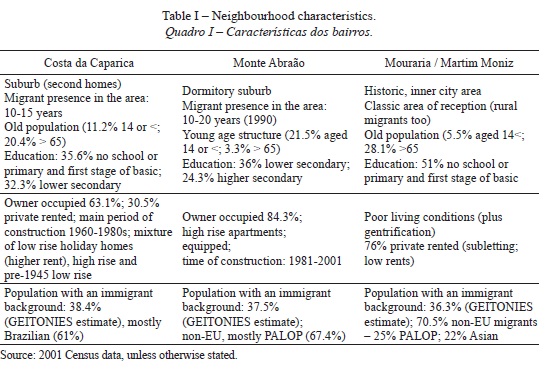
The first case-study area, Costa da Caparica, is a traditional fishing area on the coast south of the River Tagus, since transformed into a popular second home destination mainly for people living in other parts of the metropolitan area. It is a mixed area in terms of the socio-economic profile of the resident population, the age of buildings and house types, albeit almost two thirds of the housing stock is owner occupied. This heterogeneity is evident in the built environment and the spatial distribution of the population by socio-economic background resulting in fragmentation on a micro scale. The seasonal occupancy, related with the high number of second homes, has resulted in an informal rental sector. Immigrants, particularly those from Brazil, have made use of this and many rent or sublet dwellings in the area. According to the GEITONIES survey, around 38.4% of the population resident in the study area has an immigrant background of which slightly less than two thirds come from Brazil. The native population is predominantly older in comparison with the young immigrant population. The study area is diverse and encompasses several distinct subareas, characteristic of the more fragmented nature of urban areas in southern European cities.
The second area, Monte Abraão, is a dormitory suburb located on the main commuter railway line between Lisbon and Sintra. The areas along this transport route experienced significant population growth over the past 20 years as the city sprawled and underwent late suburban expansion. Thus, due to its more recent development, the resident population in the area is predominantly young and the residential buildings relatively new and privately owned. The average level of education is higher in comparison with the other case study areas. The immigrant population represents approximately 37% of the total population, with the majority originating from Portuguese-speaking African countries (PALOP). Their presence in the area represents an upwardly mobile social trajectory into the suburbs and owner occupancy. On a micro-scale, the area is fractured with immigrants tending to live in specific zones.
The third area, Mouraria / Martim Moniz, is the most diverse of the three neighbourhoods. Indeed, 29 different nationalities are represented in the survey sample of 100 immigrants. This traditional area is located in the vibrant heart of the City of Lisbon on the slopes of the Castelo de São Jorge. It is a classic area of reception with a high population turnover. Many of the native population living in the area are elderly rural migrants with no schooling and a smaller number are new gentrifiers. The internal diversity is evident spatially with immigrants living toward the bottom of the hill, older natives higher up and gentrifiers closer to the castle in the properties that boast the best views. The housing stock is mostly private rented with a very high incidence of overcrowding among immigrants. There is a high vacancy rate in the area and many of the residential buildings are in disrepair. The diversity in the area is visible in the ethnic commerce, places of worship and the ethnic and religious dress of the immigrant inhabitants. For many migrants this area is both their place of residence and work. According to GEITONIES survey data, of the 36.3% of the population with an immigrant background resident in the study areaii, 25% are from Portuguese-speaking African countries and 22% from Asia.
The sample in each of the areas was selected randomly
iii and includes 100 Portuguese natives and 100 individuals with an immigrant backgroundiv, resulting in a total sample of 600 in the Lisbon Metropolitan Area. The survey gathered socio-demographic information on each of the respondents using a biographical approach. In addition, it included thematic sections on neighbourhood cohesion, satisfaction and (interethnic) social relations. A substantial part of the questionnaire was devoted to gathering social network data both on the extended or wider social network of the respondents and close friends. For the latter, name generating questions were asked for up to eight different friends across four different types of contact – spending free time, substantive help, exchanging confidences and advice and other relationships. Furthermore, detailed questions were asked to characterise the intimate contacts of the respondents.
IV. REPRESENTATIONS OF THE NEIGHBOURHOOD
In the preceding section, some objective characteristics of the areas under study were presented, the current section advances to consider subjective representations based on GEITONIES survey results. The neighbourhood was defined quite loosely as the home space for the purposes of the survey according to each respondents subjective boundaries rather than physical demarcations. As such, the neighbourhood is represented symbolically and includes perceptions of physical and social spaces.
This analysis is based on the opinion of the respondents on five statements (table II) I am proud of my neighbourhood, I care about my neighbourhood, I enjoy daily exchanges with neighbours, I would move away from here with pleasure and I would miss the people in my neighbourhood if I moved. Responses were measured on a five-point scale: agree strongly (5); agree (4); neither agree nor disagree (3); disagree (2); and disagree strongly (1). A multiple comparison of means test (ANOVA one-way) was employed to determine the significance of differences between the mean values of the responses to each of the four questions by migration background and per neighbourhood of residence (table A and B).
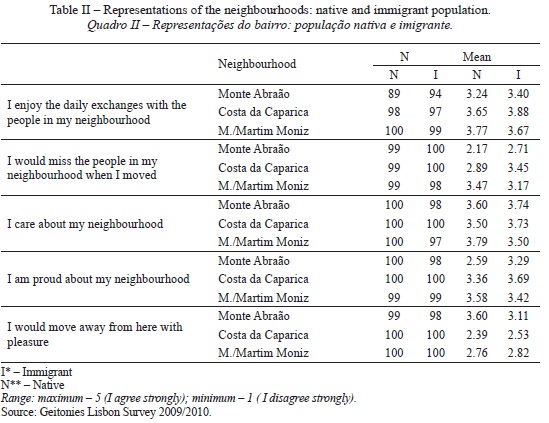
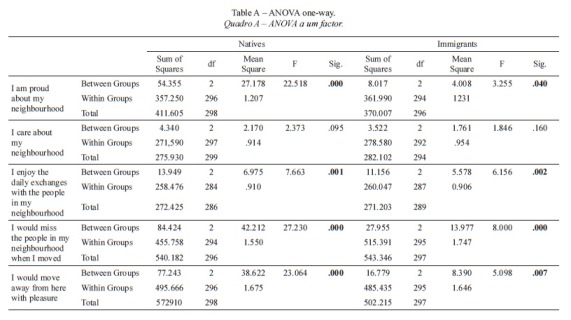
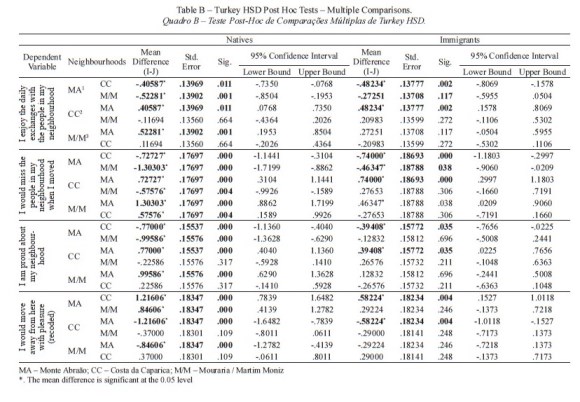
A first glance at table II reveals obvious neighbourhood tendencies across each of the statements. Respondents in Monte Abraão emerge as having the lowest levels of pride and relational attachment and the most pronounced desire to move away. Indeed, around 60% of natives and almost half of the immigrant respondents reported wanting to leave the area – mean = 3.60 and 3.11, respectively (Fonseca and McGarrigle, 2012). Furthermore, more than three quarters of natives and over half of the immigrant respondents contend that they would not miss their neighbours if they moved out of the area. While this may be true, it does not necessarily translate directly into a sense of detachment as the residents still care about the area (mean = 3.60 and 3.74 for natives and immigrants, respectively). Overall, immigrants in the area are more positive than natives, albeit they are less attached than their counterparts in other areas as seen by lower mean scores for all statements except for caring for their neighbourhood.
Generally speaking, there are similarities that can be drawn between Mouraria / Martim Moniz and Costa da Caparica as residents have more positive representations. The primary differences between the areas relate to differences according to immigrant background. In Costa da Caparica, immigrants have more positive representations than natives, yet this tendency is inversed in Mouraria / Martim Moniz (table II).
In general terms, among the immigrant respondents, those in Costa da Caparica have the strongest level of attachment to their neighbourhood. Concurrently, cognitive evaluations of weak ties among neighbours are consistent with behavioural indicators. Indeed, this group, dominated by Brazilians, has the highest level of weak ties seen through the fact that over 60% had engaged in small talk with 21 or more neighbours over the three months previous to the survey – correspondent with popular representations of Brazilians as convivial. Still, further analysis suggests that strong ties are mostly in-group (ibid.).
On the other hand, native respondents in Martim Moniz tend to have slightly more positive representations than immigrants. Many are elderly long-term residents and others are new gentrifiers who have been attracted to the area by its diversity and vibrancy. Still, there are some specificities relating to the colourful street life, the appropriation of public space and the ethnic commerce in the area that render Mouraria / Martim Moniz distinct. Veritably, local daily exchanges are enjoyed by around three quarters of both immigrants and natives (ibid.).
The mean response values are statistically significant between migrant and native groups, shown by the results of the analysis of variance (ANOVA one-way), for all statements except for caring about the neighbourhood (table A).
Looking at multiple comparisons between mean response values across neighbourhoods using Tukey HSD Post Hoc Test, one can observe interesting results (table B). For natives, there are statistically significant differences across all pairs of neighbourhoods for each respective indicator, except for sense of pride, enjoying daily exchanges and moving away with pleasure between Mouraria / Martim Moniz and Costa de Caparica. The same analysis for immigrants reveals some notable differences. Significant differences between mean response values can be seen for all questions between Costa da Caparica and Monte Abraão, even if for sense of pride it is at the 0,05 level, and, finally, between Mouraria / Martim Moniz and Monte Abraão for mean responses to I would miss the people in my neighbourhood if I moved at the 0,05 level.
V. THE MAIN DIMENSIONS OF NEIGHBOURHOOD EMBEDDEDNESS
Following the previous contextual analysis on representations and attachment, this section advances to explore how these aspects interact with actual social contacts, in the form of both strong and weak ties. To accomplish this, 18 variables were selected and grouped into four analytical dimensions.
(i) Assessment of relations, safety and cohesion in the neighbourhood;
(ii) Attachment to the neighbourhood;
(iii) Concrete contacts in the neighbourhood; and
(iv) Intimate social networks.
Factor analysis was conducted, employing the 18 variables, to identify the main factors structuring daily relations among the sample population in the case study areas. Neighbourhood embeddedness is measured here using a combination of variables that represent emotional and affective bonds rather than functional bonds table III. These indicators will enable us to assess differing levels of embeddedness in the social structure of the case study neighbourhoods.
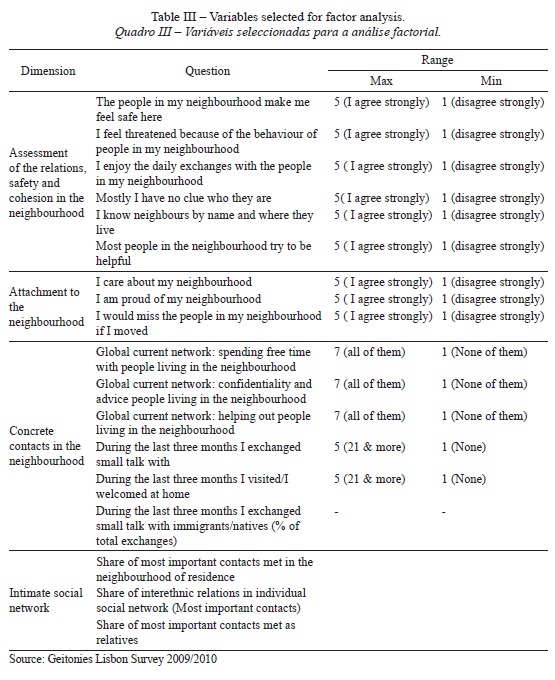
After excluding cases due to missing values 455 respondents were included in the analysis. Six factors were selected,v which combined explain 62% of the total variance (table IV).
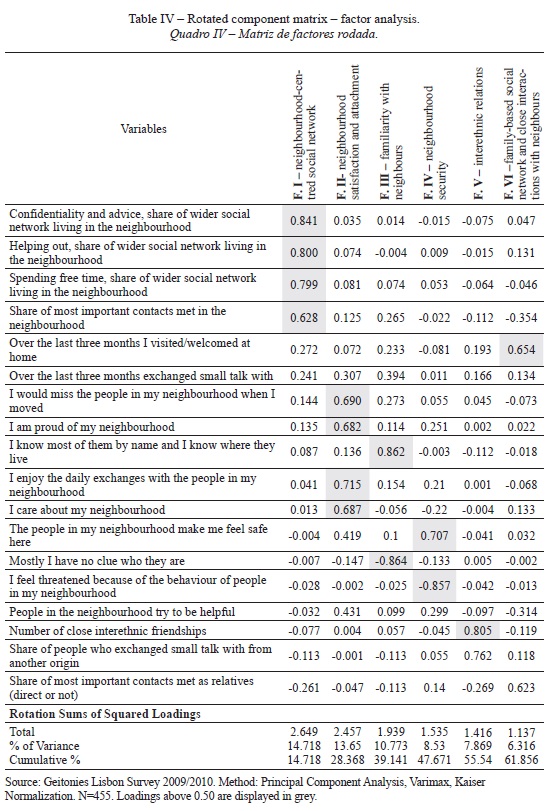
The first factor – neighbourhood-centred social network – relates to the spatiality of the respondents intimate social network and situates it inside the area of residence. It explains 14.7% of the variance and is defined by four variables: the share of friends living locally with whom the respondent spends free time and exchanges advice and help with and the share of their most intimate contacts met in the area of residence.
The second factor – neighbourhood satisfaction and attachment – explains 13.6% of the variance. The variables with the highest loadings relate to attachment, pride and caring for the area, and the residents, including enjoying daily exchanges and missing them if they moved away.
The third factor – familiarity with neighbours – relates to the level of knowledge respondents have of their neighbours and the degree of familiarity among neighbours – and explains 10.7% of the variance. This is principally cognitive and does not include measures of actual behaviour in terms of social interactions between neighbours. The variables with the highest loadings are I know most residents in the neighbourhood by name and where they live and Mostly I have no clue who the residents are.
The fourth factor – neighbourhood security – explains 8.5% of the variance, and transmits the emotional reaction of the respondents to the behaviour of fellow residents. It includes a positive and a negative affirmation: The people in my neighbourhood make me feel safe here and I feel threatened because of the behaviour of people in the neighbourhood.
The fifth factor – interethnic relations – is defined by both weak and strong interethnic ties. It includes an indicator of superficial contact, namely exchanging small talk with residents from a different origin as well as having close interethnic friends. This factor explains 7.8% of the variance.
The final factor – family-based social network and close interactions with neighbours – explains 6.3% of the variance. This factor denotes the importance of family members in the close social network and more intimate interactions with neighbours in the private sphere (home visits).
An analysis of variance (ANOVA) of the mean scores for each factor, by migration background, shows that there are statistically significant differences between the Portuguese respondents and those of immigrant origin at the 1% level, for factors IV (Neighbourhood security) and V (Inter-ethnic relations). Significant differences can also be seen at the 5% level for factor II (Neighbourhood satisfaction and attachment). These results are in accordance with the descriptive analysis of the data which, generally speaking, found that immigrants assess safety more positively than natives, tend to have more interethnic relations and are more attached to the neighbourhood of residence (Fonseca and McGarrigle, 2012).
VI. EXPLORING THE MODES OF COEXISTENCE AND NEIGHBOURHOOD EMBEDDEDNESS
In the previous section, the results of the factor analysis enabled us to reduce the variables pertaining to neighbourhood embeddedness into six clear dimensions of social interaction and attachment in the three case study areas. This section advances to develop typologies that characterize the different levels of neighbourhood embeddedness and modes of coexistence present among our sample population. We used cluster analysis (K-means) to define groups of individuals who share similar scores in the six factors extracted. As a result five clusters were identified with the number of cases per cluster ranging from 75 to 101. One-way ANOVA was used to test for differences in each factor among the five clusters. As can be observed in table C, the scores of the factors differ significantly across the five groups.
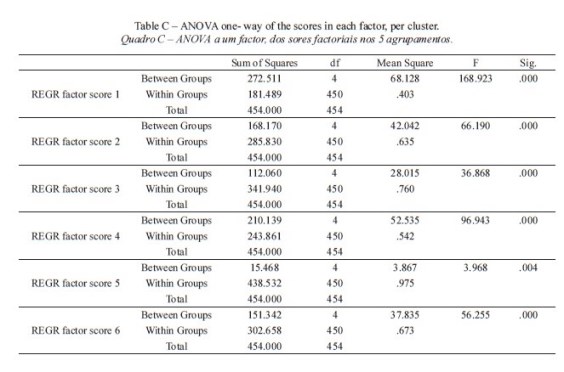
Cluster one denotes very low neighbourhood embeddedness and is characterized by high levels of insecurity. The mean score of factor IV in this cluster presents a significant difference in relation to all other factors (sig. = 0.000 for all pairs). While insecurity is expressed principally at the cognitive level with respondents feeling threatened by the behaviour of other residents, it also extends to the behavioural level and is reflected in the fact that the social networks of this cluster are developed outside the neighbourhood. The mean score for factor II is negative and also significantly different from the other clusters meaning that respondents classified in this cluster are not satisfied or attached to the area.
Cluster two is defined by a low level of embeddedness at the local level, namely low levels of attachment. The highest levels of dissatisfaction can be found in this cluster when compared with the others. However, this discontentment does not extend to feelings of insecurity or fear. Respondents tend to disagree more with the following type of statements: I enjoy the daily exchanges with people in my neighbourhood, I care about my neighbourhood, I am proud of my neighbourhood and I would miss the people in my neighbourhood when I moved. The lack of emotional bonds characteristic of this group at the local level is also reflected in more geographically dispersed close social networks (table V).
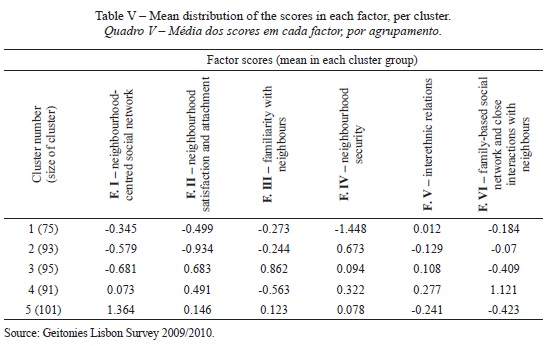
Cluster three indicates a medium level of embeddedness. It is similar to the first two clusters in that friendship networks tend to be located outside the neighbourhood, yet it differs substantially in terms of levels of embeddedness. Place attachment features quite strongly, in fact, this group is the most satisfied with the area of residence and also has the highest mean score in factor III which relates to familiarity with neighbours. The respondents represented in this cluster, therefore, are content with the area in which they live and with fellow inhabitants, yet have a more spatially versatile social network as their intimate friends tend to live elsewhere.
Cluster four is defined by medium to high neighbourhood embeddedness. This cluster is distinct from cluster three as those classified in this group have high mean scores for factor VI. Thus, the private sphere features as an important place to socialise with neighbours. The private spatiality of the network is reinforced by the centrality of relatives as elements in the social network. Despite being attached to the neighbourhood and enjoying daily interactions, this group is not familiar with neighbours. Indeed, they disagree with statements like, I know most of them by name and where they live and I have no clue who they are.
Cluster five denotes high but exclusive neighbourhood embeddedness. This cluster is unique as wider social networks are concentrated at the local level. Furthermore, the neighbourhood was also an important meeting place for intimate contacts (those identified by name generating questions). At the same time, however, local interactions appear to be confined to close friends as mean scores for factors relating to familiarity with neighbours and attachment both to the residents and the place are very low.
Bearing in mind the second of our initial questions, on the role played by the neighbourhood environment and migration background in shaping modes of embeddedness, we now analyse the distributions of the different modes of embeddedness across case study areas and background groups.
While one can observe significant area differences, in terms of modes of embeddedness, it is difficult to present one account for each neighbourhood as there is a high degree of internal heterogeneity among the population resident in each area (table VI). Residents of Costa da Caparica display the highest levels of embeddedness with over a quarter represented in mode 4 and 5 and only 7.5% with very low levels of embeddedness. Albeit almost one fifth of respondents display medium levels of embeddedness and the same share again are represented in mode 2 which denotes a low level of embeddedness.
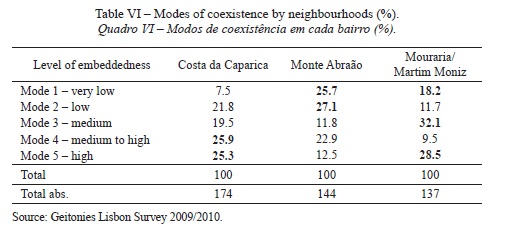
This is in clear contrast with the dormitory suburb of Monte Abraão where over half of the resident population surveyed have very low or low levels of neighbourhood embeddedness. A further 23% of respondents display medium to high levels of embeddedness (mode 4), meaning they socialise mainly in the private sphere, and while satisfied they are less familiar with their neighbours on the whole.
Lastly, Mouraria, the most diverse area in ethnic and socio-demographic terms, is distinct due to the heterogeneity of the resident population. Almost one third of respondents are represented in mode 3, whilst the rest of the population is polarised at the two extremes. Indeed, over 28% are highly embedded, albeit in exclusive circles and 18.2% are represented in mode 1 which signifies a very low level of embeddedness and insecurity.
The internal heterogeneity of the modes of embeddedness of the residents in each area is more acutely evident when the results are disaggregated by migration background (table VII).
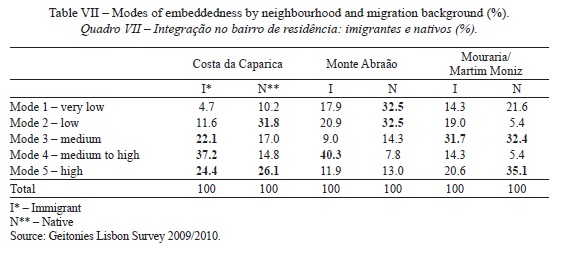
While at the general level residents of Costa da Caparica are most highly embedded in the neighbourhood, immigrants are more so. Indeed, less than 17% of the latter group displays either low or very low levels of embeddedness. The largest share of immigrants (over 32%) is represented in mode 4 denoting medium to high embeddedness. As such, socialising occurs with neighbours, mostly co-ethnics, in the private sphere, meaning that familiarity with other residents is limited. Nonetheless, these respondents are satisfied with daily interactions and are attached to the area. Moreover, they are well represented in mode 3 and mode 5, 22 and 24% respectively.
In contrast, however, while the indigenous population living in the area is represented principally in mode 2 characterised by low embeddedness (31.8%), they are quite polarised with 26.1% represented in the highest mode of embeddedness.
The segmentation of the native population reflects to a large extent the socio-spatial fragmentation at a micro level in the area. Long-term residents living in the traditional fishing area, clearly identifiable through the characteristics of the built environment, are contrasted with residents who have relatively higher levels of education resident in newer parts of the neighbourhood. Furthermore, the local key actors who participated in the focus group highlighted the importance of the regional divisions that are maintained between the native population who migrated internally from the north and south of the country.
Despite the proximity in terms of socio-economic status between natives and migrants in Monte Abraão, there are clear contrasts in terms of the modes in which they are represented. The majority of natives (65%) display a low level of attachment to the neighbourhood compared with 38% of immigrants – higher than equivalent values for immigrants in the other areas. The local key actors expressed some surprise at this as they had assumed that immigrants would be more attached to the area, whereas they expected natives to feel unsafe and have fewer connections due to the increasing ethnic mix of the area. In spite of this, the largest share of immigrant respondents in Monte Abraão (40.3 %), for the most part from Portuguese-speaking African countries, is represented in mode 4 which denotes a medium to high level of embeddedness. Thus, social interactions with neighbours are confined mostly to the private sphere and weak ties limited, which may potentially undermine neighbourhood cohesion.
As mentioned previously, over two-thirds of natives are represented in the bottom two modes (mode 1 and 2). The most important distinction between these modes is sense of security. The first group (32.5%) feels insecure and threatened by the behaviour of neighbours, while levels of general satisfaction are lower. The second group is more or less inversed with high dissatisfaction and low levels of insecurity. Both groups have developed their social networks entirely outside the area representative of high levels of mobility associated with commuting. The differences between natives and immigrants in this area can, in part, be explained by the significance that the neighbourhood has as a status marker. For natives, satisfaction has diminished over time in line with the perceived worsening reputation of the area due to immigrant presence (Fonseca and McGarrigle, 2012). On the contrary, moving into the area and into owner occupancy represents upward social mobility for some of the immigrants surveyed. According to key actors, young immigrant families were attracted to the most recently built part of the area, which has resulted in a degree of physical separation. Given that a greater choice, in residential terms, was exercised when buying in this area, one may have expected levels of attachment to be higher. Local key actors blamed the built environment, namely high-rise buildings and the lack of public spaces and commerce as well as the dormitory nature of the area for the paucity of local social ties.
In Mouraria, there is a degree of convergence between natives and migrants as almost one third of each group is represented in mode 3 with a medium level of embeddedness. The share of the immigrant population that is represented in the modes denoting lower levels of embeddedness (modes 1 and 2) is intermediary with respect to the other areas. Yet, given the higher share with medium levels of embeddedness they are underrepresented in comparative terms in modes characterised by high levels of embeddedness. Indeed, it is the only place in which the sum of modes 1 and 2 is greater for immigrants than for natives. The fact that the area is an entry point for migrants coming to the city and the subsequent high population turnover is a likely explanation. Thus, bonds may not be particularly strong as transience is high.
On the whole, while natives are dispersed across modes, they are more highly embedded when compared to their counterparts in other areas – 35.1% are represented in mode 5. Likewise, the percentage represented in the bottom two modes is considerably smaller. Still, a substantial number of respondents do not feel safe in the area (mode 1). The heterogeneity of levels of attachment of native respondents, like in Costa da Caparica, reflects the social and residential differences within the group, evident in the internal spatial organisation of the area. In the words of one of the local key actors,
There are two very distinct Mourarias The buildings and the population, everything is different (between the two). (Local key actor, Mouraria)
It is clear from the multiplicity of modes represented per area that the neighbourhood itself does not influence the levels of attachment that residents develop in the same way, that is, the neighbourhood effect is not the same for all residents. This is exacerbated in the three Lisbon case study areas by the internal fragmentation of the areas on a very micro scale. In general terms, natives are less attached to their place of residents than immigrants, and in the context of ethnicization, more often evaluate its evolution negatively (Fonseca and McGarrigle, 2012). An exception to this is Mouraria, where older natives who feel insecure in the area are contrasted with gentrifiers who tend to value the cultural diversity, yet live slightly beyond its reach in refurbished properties closer to the castle.
VII. MODES OF COEXISTENCE: NEIGHBOURHOOD AND COMPOSITIONAL EFFECTS
Besides neighbourhood effects, compositional effects have been rendered important predictors of attachment. In our analysis of the relationship between levels of embeddedness and individual factors we found divergent patterns. Indeed, age and sex, proven to be important predictors in other studies, are not significant here (Goudy, 1982; Hidalgo and Hernandez, 2001). The same can be said for belonging to a religion and family status. Education level is insignificant for all groups except natives living in the dormitory suburb of Monte Abraão. The relationship, however, is inversed, compared with other findings (Woolever, 1992), as those with higher levels of education are less embedded, perhaps representative of a disconnection between social identity and belonging in the context of the shifting socio-ethnic composition of the area. Length of residence is only significant for immigrants living in Martim Moniz (table VIII), likely an effect of the super-diversity of this inner-city area. Integration into existing social structures may be easier when levels of diversity are lower and similarities between group members greater.
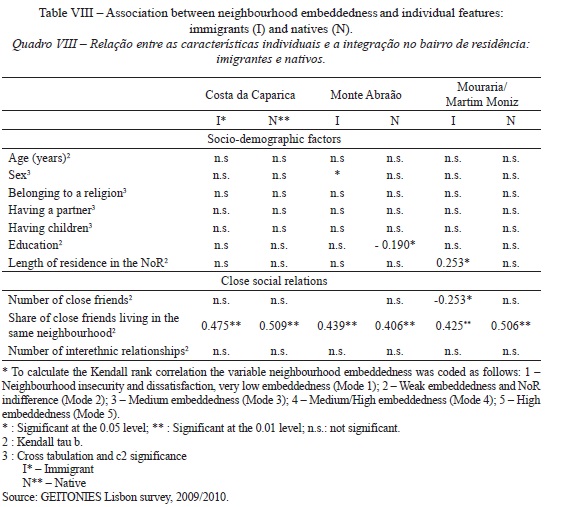
Thus, in this case, our results suggest that socio-demographic characteristics are not important predictors of neighbourhood embeddedness or attachment. On the other hand, locally-based social networks and the presence of strong ties in the area contribute clearly to levels of neighbourhood attachment. This is unequivocal across all case study areas and independent of migration background, reiterating the findings of Kohlbacher et al. (2012). Likewise, earlier studies on residential mobility also stress community ties as offsetting a decision to move (Wolpert, 1966; Speare, 1974). We know that social relations provide a crucial supply of support (Granovetter, 1995). However, in this instance we do not know if the nature of social relations among residents in our case study areas is expressive or instrumental (Lin, 2001).
The importance of strong ties in producing high levels of embeddedness is underlined again in the following table (table IX). The share of respondents, regardless of migration background, who have no close friendships with residents living locally decreases as levels of embeddedness increase. Certainly, most respondents with high levels of attachment have close friends in the neighbourhood, albeit mostly in-group. While in general terms, this tendency is evident among natives in Monte Abraão, a higher percentage (20%) of respondents with high levels of embeddedness do not have close friends in the area reflecting higher levels of daily mobility. Recent increases in population turnover might also explain this as close friends first met in the neighbourhood may well have since moved on. Interestingly, of the natives highly embedded in their neighbourhood, a higher share of those in Monte Abraão has developed interethnic relations (10%). Similarly, immigrant respondents in Monte Abraão with medium to high levels of attachment have higher shares of interethnic relations.
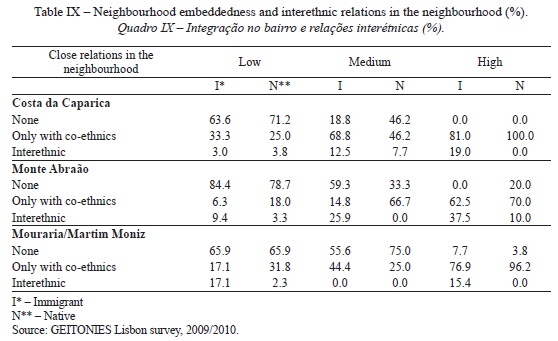
Thus, close social ties in the neighbourhood appear to positively influence attachment. In spite of this, it is important to keep in mind the fifth of natives in Monte Abraão who despite being highly embedded in the area had no close ties there. This may indicate that in certain neighbourhood contexts, especially dormitory ones, where mobility and socio-economic status are higher strong ties may be less important.
FINAL REMARKS
In this exploratory study we have found the nature and level of embeddedness that the residents of our case study areas display to be extremely heterogeneous. Whilst common measures of neighbourhood attachment were employed, we also used the respondents assessment of neighbouring relations, safety and cohesion as well as behavioural indicators measuring concrete contacts and their development at the local level. The results of this exploratory analysis highlight the diverse ways in which processes of neighbourhood attachment are experienced. In line with the primary objective we identified five modes of embeddedness, ranging from mode 1 denoting very low levels of embeddedness to mode 5 representing high embedded-ness. The modes identified reveal the complexity involved in the study of neighbourhood embeddedness. The differences between the top and bottom modes illustrate this well. Mode 1 is characterised by a sense of insecurity in the neighbourhood, whereas the cluster of respondents represented in mode two feel safe but are much less satisfied. The top mode is differentiated by the fact that while the close friends of the respondents in this cluster reside locally and comprise an important support network, they are not familiar with neighbours in general terms. This in some ways may represent a hunkering down into tight and exclusive networks rather than embracing the social change that has served to transform each of the neighbourhoods over recent years.
Evidence presented suggests that, in this specific case, the effect of the neighbourhood on determining attachment is not uniform. The heterogeneous distribution of respondents across clusters in each area illustrates this. Furthermore, the internal fragmentation of each of the study areas makes such an effect difficult to measure. The same can be said for migrant background, albeit there are some general tendencies that can be pointed out. Indeed, immigrants on the whole are more attached, likely due to immigrant support networks that have developed locally. Still, this trend is less clear cut in Mouraria, where there appear to be two effects at play. The first is the heterogeneity of the native population with older natives subjected to the rapid growth in ethnic diversity in the area compared to the select group of gentrifiers who chose the area precisely for this reason. Secondly, immigrants in Mouraria were the only group studied for which length of residence contributed to levels of attachment, suggesting, in support of recent theory on local social capital, that greater diversity may slow down the development of bonds.
In terms of compositional or individual effects, socio-demographic characteristics proved to be of little relevance in predicting levels of attachment. Select socio-demographic variables were only relevant in a couple of cases. Granting that many classical studies conclude to the contrary, Parkes et al. (2002) found neighbourhood perceptions to be more important than socio-demographic effects on area dissatisfaction. On the other hand, in the present study, social ties were found to profoundly influence neighbourhood embeddedness supporting the findings of Kohlbacher et al. (2012), in their study on Vienna. The importance of locally-based social networks in creating high levels of embeddedness suggests that psychosocial factors are central to attachment especially in traditional areas where residents may be less mobile. Nonetheless, it is important to highlight that among some groups and in certain neighbourhood contexts, especially dormitory ones, where mobility is necessarily greater, local social ties may be less important in determining higher levels of embeddedness. Finally, high levels of embeddedness and local social ties may not perpetuate greater cohesion but may take the form of privatised in-group relations.
[ Links ]
Andersen H S (2008) Why do residents want to leave deprived neighbourhoods? The importance of residents subjective evaluations of their neighbourhood and its reputation. Journal of Housing and the Built Environment, 23(2): 79-101. [ Links ]
Bailey N, Kearns A, Livingston M (2012) Place attachment in deprived neighbourhoods: the impacts of population turnover and social mix. Housing Studies, 27(2): 208-231. [ Links ]
Bolt G, Hooimeijer P, van Kempen R (2002) Ethnic segregation in the Netherlands: new patterns, new policies? Tijdschrift voor Economische en Sociale Geografie, 93(2): 214-220. [ Links ]
Bouma-Doff W (2007) Confined contact: residential segregation and ethnic bridges in the Netherlands. Urban Studies, 44(5/6): 997-1017. [ Links ]
Beyerlein K, Hipp J R (2005) Social capital, too much of a good thing? American religious traditions and community crime. Social Forces, 84: 995-1013. [ Links ]
Fararo T J, Skvoretz J (1987) Unification research programs: integrating two structural theories. American Journal of Sociology, 92: 1183-1209. [ Links ]
Fonseca M L, McGarrigle J, Esteves A, Malheiros J (2008) Lisbon city report – GEITONIES. Lisbon. [Accessed 24 September 2012]. http://geitonies.fl.ul.pt/Publication/LIsBON%20City%20Report.pdf.
Fonseca M L, McGarrigle J (Coord.) et al. (2012) Modes of inter-ethnic coexistence in three neighbourhoods in Lisbon Metropolitan Area: a comparative perspective. Edições Colibri / Centro de Estudos Geográficos, Lisboa. [ Links ]
Forrest R, Kearns A (2001) Social cohesion, social capital and the neighbourhood. Urban Studies. November, 38(12): 2125-2143. [ Links ]
Gesthuizen M, Van der Meer T, Scheepers P (2009) Ethnic diversity and social capital in Europe: tests of Putnam's thesis in European countries. Scandinavian Political Studies, 32(2): 121-142. [ Links ]
Giuliani M V (2003) Theory of attachment and place attachment. In Bonnes M, Lee T, Bonainto M (Eds) Psychological theories for environmental issues. Aldershot, Ashgate: 137-170.
Glaster G (2001) On the nature of neighbourhood. Urban Studies, 38(12): 2111-2124. [ Links ]
Goudy W J (1982) Further consideration of indicators of community attachment. Social Indicators Research, 11(2): 181-192. [ Links ]
Granovetter M (1995) Getting a job. Chicago, University of Chicago Press. [ Links ]
Hidalgo M C, Hernandez B (2001) Place attachment: conceptual and empirical questions. Journal of Environmental Psychology, 21: 273-281. [ Links ]
Hipp J R, Perrin A (2006) Nested loyalties: local networks' effects on neighbourhood and community cohesion. Urban Studies, 43: 2503-2523. [ Links ]
Ivarsflaten E, Strømsnes K (2010) Inequality, diversity and social trust in Norwegian communities. National Norwegian Conference in Political Science, Kristiansand, January 2010. [ Links ]
Kasarda J D, Janowitz M (1974) Community attachment in mass society. American Sociological Review, 39: 328-339. [ Links ]
Kearns A, Forrest R (2000) Social cohesion and multilevel urban governance. Urban Studies, 37(5-6): 995-1017. [ Links ]
Kearns A, Parkinson M (2001) The significance of neighbourhood. Urban Studies, 38: 2103-2110. [ Links ]
Kohlbacher J, Reeger U, Schnell P (2012) Neighbourhood embeddedness and social coexistence. Vienna, ISR-Forschungsberichte. [ Links ]
Letki N (2008) Does diversity erode social cohesion? Social capital and race in British neighbourhoods. Political Studies, 56(1): 99-126. [ Links ]
Lin N (2001) Social capital. A theory of social structure and action. Cambridge, Cambridge University Press. [ Links ]
Livingston M, Bailey N, Kearns A (2010) Neighbourhood attachment in deprived areas: evidence from the north of England. Journal of Housing and the Built Environment, 25(4): 409-427. [ Links ]
Livingston M, Bailey N, Kearns A (2008) Peoples attachment to place: the influence of neighbourhood deprivation. Coventry, Chartered Institute for Housing/Joseph Rowntree Foundation. [ Links ]
Massey D, Denton N (1993) American apartheid: segregation and the making of the underclass. Harvard University Press. [ Links ]
Musterd S (2003) Segregation and integration: a contested relationship. Journal of Ethnic and Migration Studies, 29(4): 623-641. [ Links ]
Parkes A, Kearns A, Atkinson R (2002) What makes people dissatisfied with their neighbourhoods? Urban Studies, 39 (13): 2413-2438. [ Links ]
Pinkster F, Völker B (2009) Local social networks and social resources in two Dutch neighbourhoods. Housing Studies, 24(2): 225-242. [ Links ]
Putnam R D (2007) E Pluribus Unum: diversity and community in the twenty-first century. The 2006 Johan Skytte prize lecture. Scandinavian Political Studies, 30(2): 137-174. [ Links ]
Putnam R D (2000) Bowling alone: the collapse and revival of the American community. New York, Simon & Schuster. [ Links ]
Riger S, Lavrakas P (1981) Community ties patterns of attachment and social interaction in urban neighborhoods. American Journal of Community Psychology, 9: 55-66. [ Links ]
Sampson R J (1988) Local friendship ties and community attachment in mass society: A multi-level systemic model. American Sociological Review, 53: 766-779. [ Links ]
Sampson R J, Morenoff J D, Gannon-Rowley T (2002) Assessing neighbourhood effects: social processes and new directions in research. Annual Review of Sociology, 28: 443-478. [ Links ]
Savage M, Bagnall G, Longhurst B (2005) Globalization and belonging. Sage, London. [ Links ]
Semyonov M, Glickman A (2009) Ethnic residential segregation, social contacts, and anti-minority attitudes in European societies. European Sociological Review, 25(6): 693-708. [ Links ]
Speare A J (1974) Residential satisfaction as an intervening variable in residential mobility. Demography, 11(2): 173-188. [ Links ]
Sturgis P, Brunton-Smith I, Read S, Allum N (2011) Does ethnic diversity erode trust? Putnams hunkering down? Thesis reconsidered. British Journal of Political Science, 41(01): 57-82. [ Links ]
Suttles G (1972) The social construction of communities. Chicago, University of Chicago Press. [ Links ]
Taylor R B, Gottfredson S D, Brower S (1985) Attachment to place: discriminant validity and impact of disorder and diversity. American Journal of Community Psychology, 13: 525-542. [ Links ]
Wolpert J (1966) Migration as an adjustment to environmental stress. Journal of Social Issues, 22(4): 92-102. [ Links ]
Woolever C (1992) A contextual approach to neighbourhood attachment. Urban Studies, 29: 99-116. [ Links ]
Received: October 2012. Accepted: March 2013
FUNDING
This research has received funding from the European Union Seventh Framework Programme (FP7/2007-2011) under grant agreement nº 216184 (GEITONIES PROJECT).
NOTES
i Please find a description of the GEITONIES project in the introductory chapter of this special issue.
iiEstimated according to GEITONIES data.
iiiAn inventory of addresses was generated and residential units were randomly selected, within each household the interviewee was randomly selected from household members aged 25 or older using the birthday method.
ivThe concept of immigrant background adopted in the GEITONIES survey refers to a person who has at least one parent born outside the country of residence.
vEach with an Eigenvalue of 1 or more after Varimax Rotation.














